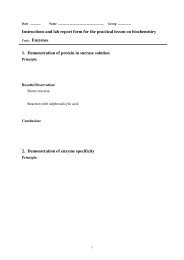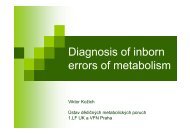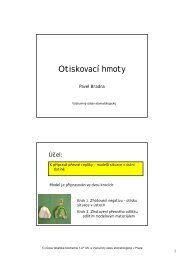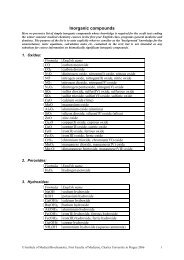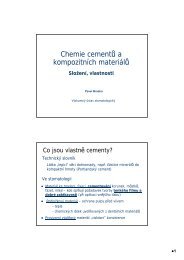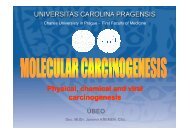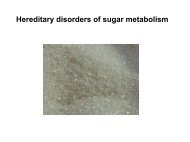What Is A Free Radical - Ãstav lékaÅské chemie a biochemie
What Is A Free Radical - Ãstav lékaÅské chemie a biochemie
What Is A Free Radical - Ãstav lékaÅské chemie a biochemie
You also want an ePaper? Increase the reach of your titles
YUMPU automatically turns print PDFs into web optimized ePapers that Google loves.
Reactive Oxygen Species<br />
in the Body<br />
Antioxidant Defence<br />
Jan Pláteník MD, PhD<br />
Ústav lékařské bio<strong>chemie</strong> 1.LF UK<br />
<strong>What</strong> is a free radical ?<br />
- any chemical species (molecule, atom, ion)<br />
capable of independent existence that contains<br />
at least one unpaired electron<br />
radical<br />
O 2·–<br />
ion<br />
molecule<br />
1
For what do we need oxygen?<br />
Transfer of electrons (oxidation) from organic substances to<br />
oxygen releases huge amount of energy<br />
E.g. Glucose:<br />
C 6 H 12 O 6 + 6 O 2 → 6 CO 2 + 6 H 2 O<br />
∆G o ’ = – 2820 kJ/ mol (180 g of glucos<br />
ose)<br />
In addition, reactivity of oxygen can be controlled by catalysis<br />
with transition metals (iron, copper)<br />
Does sugar burn ?<br />
2
Spin restriction of dioxygen<br />
• Normal (triplet) O 2 is a<br />
biradical, with high<br />
affinity to electrons<br />
• But gain of an electron<br />
requires one of the<br />
unpaired electrons<br />
changes its spin, which is<br />
a slow process.<br />
• That’s why we do not<br />
burn in the air<br />
• Singlet O 2 is an excited,<br />
highly reactive species<br />
Respiratory chain in the<br />
mitochondrial inner membrane<br />
4
The respiratory chain:<br />
..ele<br />
electrons flow ‘downhill’ and<br />
terminate at oxygen<br />
Overall reaction:<br />
NADH + H + + 1/2 O 2 → NAD + + H 2 O<br />
∆G o ’ = –219.25 kJ mol -1<br />
..and<br />
resulting proton gradient powersp<br />
ATP synthesis<br />
5
Reactive oxygen species (ROS, ‘oxygen radicals’) can be<br />
derived from intermediates of oxygen reduction to water:<br />
O 2<br />
+4 e-<br />
(+4 H + )<br />
+1 e-<br />
O 2·–<br />
superoxide<br />
+2 e-<br />
(+2 H + )<br />
H 2 O 2<br />
hydrogen peroxide<br />
+3 e-<br />
(+3 H + )<br />
2H 2 O<br />
OH·<br />
hydroxyl<br />
radical<br />
( +H 2 O )<br />
Superoxide<br />
O 2·–<br />
• Sources in the body:<br />
– Escape of electrons to oxygen<br />
- Respiratory chain in mitochondria<br />
- Other similar redox carrier systems, e.g. microsomal<br />
cytochrome P450 monooxygenase<br />
– NAD(P)H Oxidase:<br />
- Phagocytes (”respiratory burst”)<br />
- Non-phagocytic cells<br />
– Some enzymes:<br />
- Xanthine oxidase<br />
- Cyclooxygenase<br />
- Lipoxygenase<br />
– Reaction of FeII-hemoglobin with oxygen<br />
– Autoxidation (reaction with oxygen) of various compounds<br />
(ascorbate, glutathione and other thiols, catecholamines)<br />
6
Superoxide originates in the<br />
mitochondrial respiratory chain<br />
• 1-2 % from total<br />
oxygen consumption<br />
• Escape of electrons<br />
from redox centers of<br />
complexes I and III,<br />
mostly from<br />
semiquinone<br />
Respiratory burst of phagocyte<br />
7
Origin of superoxide from oxyhemoglobin<br />
Štípek S et al.: Antioxidanty a volné radikály ve zdraví a nemoci. Grada<br />
Publishing, Praha, 2000.<br />
Superoxide<br />
• Properties:<br />
- Moderate reactivity, both oxidising and reducing<br />
agent<br />
- Limited ability to cross biological membranes (only<br />
through anion channels or in its protonated form)<br />
- Releases iron from Fe-S clusters<br />
• Fate:<br />
– Dismutation:<br />
O 2·–<br />
O 2·–<br />
+ O 2·–<br />
+ 2 H + → O 2 + H 2 O 2<br />
– Reaction with nitric oxide:<br />
NO· + O 2·–<br />
→ OONO – (peroxynitrite)<br />
8
Hydrogen peroxide<br />
H 2 O 2<br />
• Formation in the body:<br />
– Dismutation of superoxide (spontaneous or<br />
catalyzed by superoxide dismutase)<br />
O 2·–<br />
+ O 2·–<br />
+ 2 H + → O 2 + H 2 O 2<br />
– Directly by action of some enzymes:<br />
• Xanthine oxidase<br />
• Monoamine oxidase (MAO)<br />
Hydrogen peroxide<br />
• Properties:<br />
- No radical<br />
- <strong>Free</strong>ly crosses biological membranes<br />
- Fairly unreactive as such<br />
- But rapidly reacts with reduced transition metals such<br />
as iron, copper (the Fenton reaction)<br />
• Fate:<br />
– The Fenton reaction:<br />
H 2 O 2<br />
hydroxyl radical<br />
H 2 O 2 + Fe 2+ → OH – + OH· + Fe 3+<br />
– Safe decomposition by glutathione peroxidase or<br />
catalase<br />
9
Hydroxyl radical<br />
• Formation in the body:<br />
– Ionising radiation:<br />
H 2 O → H· + OH·<br />
OH ·<br />
– The Fenton reaction:<br />
H 2 O 2 + Fe 2+ → OH – + OH· + Fe 3+<br />
• Properties:<br />
- Extremely high reactivity. Damages biomolecules<br />
near its site of formation.<br />
Reactive Oxygen Species (ROS)<br />
• <strong>Radical</strong>s:<br />
– Superoxide, O 2·–<br />
– Hydroperoxyl radical, HO 2·<br />
– Hydroxyl radical, OH·<br />
– Peroxyl radicals, ROO·<br />
– Alkoxyl radicals, RO·<br />
• Non-radicals:<br />
– Hydrogen peroxide, H 2 O 2<br />
– Hypochlorous acid, HClO<br />
– Ozone O 3<br />
– Singlet oxygen, 1 O 2<br />
10
Nitric oxide<br />
• Formation in the body:<br />
NO ·<br />
– NO synthase-catalysed reaction:<br />
L-Arginine + O 2<br />
+ NADPH → L-Citrulline + NADP + +NO·<br />
– Three different NO synthases:<br />
- NOS I (neuronal, constitutive)<br />
- NOS II (phagocytes, inducible)<br />
- NOS III (endothelial, constitutive)<br />
Nitric oxide<br />
• Properties:<br />
- Gaseous radical<br />
- Reaction with heme iron of guanylate cyclase<br />
(…physiological effects)<br />
- Reaction with heme iron of hemoglobin (…physiological<br />
inactivation)<br />
- Reaction with sulfhydryl groups on glutathione etc. to<br />
nitrosothiol (…transport NO)<br />
- Reaction with superoxide to peroxynitrite and finally<br />
hydroxyl radical (…toxicity):<br />
NO· + O 2·–<br />
→ OONO – peroxynitrite<br />
NO ·<br />
OONO – + H + → HOONO → OH· + NO 2 ·<br />
peroxynitrous acid<br />
hydroxyl radical<br />
11
NO causes relaxation of smooth muscles in blood<br />
vessel wall:<br />
Reactive Nitrogen Species (RNS)<br />
• <strong>Radical</strong>s:<br />
– Nitric oxide, NO·<br />
– Nitric dioxide, NO 2 ·<br />
• Non-radicals:<br />
– Nitrosonium, NO +<br />
– Nitroxyl, NO –<br />
– Nitrous acid, HNO 2<br />
– Dinitrogen trioxide, N 2 O 3<br />
– Dinitrogen tetraoxide, N 2 O 4<br />
– Nitronium, NO 2<br />
+<br />
– Peroxynitrite, ONOO –<br />
– Alkylperoxynitrite, ROONO<br />
12
Oxidative damage to biomolecules<br />
• Lipids: peroxidation of polyunsaturated<br />
fatty acids in membranes<br />
• Proteins: oxidation of -SH, carbonylation -<br />
NH 2 , hydroxylation/nitrosylation of<br />
aromatic AA, cross-linking, degradation<br />
• Nucleic acids: strand breaks, hydroxylation<br />
of bases ... mutation, cancerogenesis<br />
Lipid peroxidation<br />
(rancidity)<br />
13
Further fate of lipid peroxides<br />
Ionising radiation:<br />
Hydroxyl radical originates from ionisation of water:<br />
H 2 O + hν → H· + OH·<br />
Reactive oxygen species in the body:<br />
One-electron reduction of oxygen (mitochondria,<br />
NADPH oxidase) forms superoxide O 2·–<br />
Dismutation of superoxide produces hydrogen peroxide:<br />
O 2·–<br />
+ O 2·–<br />
+ 2 H + → O 2 + H 2 O 2<br />
Fenton reaction with Fe or Cu converts peroxide to<br />
hydroxyl radical:<br />
H 2 O 2 + Fe 2+ → OH – + OH· + Fe 3+<br />
14
Where RONS are beneficial:<br />
Monooxygenases (cytochrome P450): hydroxylation<br />
of steroids, xenobiotics etc.<br />
Mechanism: basically a controlled Fenton reaction<br />
Fe 3+ + SH + 2 e- + O 2 + H + → FeOOH SH<br />
FeOOH SH → FeO 3+ SH + H 2 O<br />
FeO 3+ SH → FeOH 3+ S• → Fe 3+ SOH → Fe 3+ + SOH<br />
Where RONS are beneficial:<br />
• Monooxygenases: hydroxylation of steroids,<br />
xenobiotics etc.<br />
• Phagocyte weapons: killing microbes or cancer cells<br />
• Mediators of inflammatory reaction<br />
15
Beneficial ROS:<br />
Respiratory<br />
burst of<br />
neutrophilic granulocyte<br />
© 1998 Garland Publishing<br />
Where RONS are beneficial:<br />
• Monooxygenases: hydroxylation of steroids,<br />
xenobiotics etc.<br />
• Phagocyte weapons: killing microbes or cancer cells<br />
• Mediators of inflammatory reaction<br />
• Local hormones/mediators:<br />
- NO:<br />
- smooth muscle relaxation in blood vessels, gastrointestinal tract,<br />
corpus cavernosum penis<br />
- neurotransmitter/ neuromodulator in the CNS, function in<br />
synaptic plasticity, learning & memory<br />
- inhibition of thrombocyte adhesion & aggregation, leucocyte<br />
adhesion<br />
Superoxide as well with effects opposing NO ?<br />
16
Concept of redox signaling<br />
• Redox environment inside the cell –<br />
determined mostly by ratios GSH/GSSG<br />
and NADH/NAD<br />
• Redox sensors on proteins:<br />
– critical -SH groups<br />
– Fe-S centers<br />
• Targets of redox signaling:<br />
– transcription factors<br />
– protein kinases and phosphatases<br />
Redox<br />
signaling<br />
• Oxidative stress activates<br />
certain protein kinases and<br />
transcription factors<br />
• Outcome: e.g. stimulation<br />
of proliferation, or cellular<br />
senescence (ageing)<br />
• Actions of<br />
ROS/antioxidants in the<br />
cell can be very specific<br />
(T. Finkel & N.J. Holbrook, Nature 408 (2000), 239-247)<br />
17
…and very complex<br />
Oxidative stress<br />
• Levels of reactive oxygen species are kept<br />
within certain limits by mechanisms of<br />
antioxidant defence<br />
• Oxidative stress occurs if the<br />
oxidant/antioxidant balance shifts to<br />
oxidation<br />
18
Antioxidant defence<br />
• prevention of ROS/RNS formation<br />
(regulation of producing enzymes,<br />
sequestration of metals)<br />
• scavenging, trapping and quenching of<br />
radicals<br />
• reparation systems (phospholipases,<br />
proteasome, DNA repair)<br />
Antioxidant in food chemistry<br />
• Reducing agent capable<br />
of terminating chain<br />
reaction of lipid<br />
peroxidation<br />
…“chain-breaking” ...<br />
• E.g.:<br />
– Butylated<br />
hydroxytoluene (BHT)<br />
– Butylated hydroxyanisol<br />
(BHA)<br />
– Tocopherol (Vitamin E)<br />
19
Antioxidant defence of human body<br />
• Anatomy of the body limiting tissue oxygen<br />
• Antioxidant enzymes<br />
• Sequestration of redox active metals<br />
• Antioxidant substrates (scavengers)<br />
• Stress response<br />
• (Repair systems)<br />
O 2<br />
First organism<br />
(anaerobic)<br />
?<br />
Develop<br />
antioxidant<br />
defence ?<br />
Die out ?<br />
Resort to<br />
anaerobic<br />
condition ?<br />
20
Clump together !<br />
O 2<br />
O 2<br />
Antioxidant defence I<br />
Regulation of tissue O 2<br />
Inhaled air: 160 mmHg O 2<br />
Lung capillaries: 100 mmHg O 2<br />
Arterial blood: 85 mmHg O 2<br />
Arterioles: 70 mmHg O 2<br />
Capillaries: 50 mmHg O 2<br />
Cells: 1-10 mmHg O 2<br />
Mitochondria: < 0,5 mmHg O 2<br />
Fig: Wikipedia<br />
21
Mitochondria originated from<br />
phagocyted/parasitic bacteria ...<br />
Antioxidant defence II<br />
Antioxidant enzymes<br />
• Superoxide dismutase:<br />
O 2·–<br />
+ O 2·–<br />
+ 2 H + → O 2 + H 2 O 2<br />
• Catalase:<br />
2 H 2 O 2 → 2 H 2 O + O 2<br />
• Glutathione peroxidase, peroxiredoxin:<br />
H 2 O 2 + 2 R-SH → 2 H 2 O + RS-SR<br />
22
Superoxide dismutase (SOD)<br />
• Catalyses dismutation of superoxide:<br />
O 2·–<br />
+ O 2·–<br />
+ 2 H + → O 2 + H 2 O 2<br />
• Absolutely required for life in oxygen<br />
• SOD1: Cu+Zn (cytosol of eukaryotic cells)<br />
• SOD2:<br />
– Mn (mitochondrial matrix)<br />
– Fe (bacteria)<br />
• EC-SOD (SOD3): extracelullar, Cu+Zn,<br />
– MW 135,000; binds to heparane sulfate on the<br />
inner surface of blood vessels<br />
Glutathione peroxidases (GPX)<br />
• Reduction of peroxides coupled to oxidation of<br />
glutathione:<br />
2 GSH + H 2 O 2 → GS-SG + 2 H 2 O<br />
(glutathione is subsequently regenerated by<br />
glutathione reductases)<br />
• Active site contains selenocysteine<br />
• Cytosolic glutathione peroxidase:<br />
– reduces H 2 O 2 and LOOH after release from<br />
phospholipids<br />
• Phospholipide hydroperoxide-GSH-peroxidase:<br />
– reduces LOOH even in membranes<br />
23
Glutathione (GSH/GSSG)<br />
• tripeptide, in every cell<br />
1-10 mM<br />
• keeps ICT reduced<br />
• substrate for GPX, etc.<br />
• also non-enzymatic<br />
reactions with ROS and<br />
mixed disulfides with<br />
proteins ... products of<br />
GSH oxidation are toxic<br />
for cell<br />
• in oxidative stress the<br />
cell exports GSSG out<br />
Catalase<br />
• Tetramer, every subunit contains heme with<br />
Fe<br />
• Dismutation of hydrogen peroxide:<br />
2 H 2 O 2 → 2 H 2 O + O 2<br />
• Red blood cells, peroxisomes<br />
• Also peroxidase activity:<br />
H 2 O 2 + ROOH → H 2 O + ROH + O 2<br />
(in comparison to GPX less significant)<br />
24
Oxidation<br />
of very long chain fatty acids in peroxisome<br />
oxisomes:<br />
O 2·–<br />
Superoxide dismutase<br />
H 2 O 2<br />
H 2 O<br />
Glutathione<br />
peroxidase<br />
GSH<br />
Reduced glutathione<br />
(GSH)<br />
GS-SG Oxidised glutathione NADP +<br />
(GS-SG)<br />
Glutathione<br />
reductase<br />
NADPH+H +<br />
Transhydrogenase<br />
NAD +<br />
NADH+H +<br />
Pentose cycle<br />
ATP<br />
25
Peroxiredoxin/Thioredoxin<br />
• Recently discovered antioxidant system,<br />
more important for removal of hydrogen<br />
peroxide than GPX<br />
O 2·–<br />
Superoxide dismutase<br />
NADPH+H +<br />
H 2 O 2<br />
Peroxiredoxin<br />
RED<br />
Thioredoxin<br />
RED<br />
Thioredoxin<br />
reductase RED<br />
SH HS<br />
SH HS<br />
FADH 2 (Se)<br />
GSH<br />
Peroxiredoxin<br />
OX<br />
Thioredoxin<br />
OX<br />
Thioredoxin<br />
reductase OX<br />
H 2 O<br />
S<br />
S<br />
S<br />
S<br />
FAD (Se)<br />
NADP +<br />
26
Antioxidant defence III<br />
Sequestration of metals<br />
• Redox-active transition metals (Fe, Cu)<br />
accept/donate one electron easily<br />
– ... alleviation of spin restriction of dioxygen<br />
– ... metals are in active centers of all oxygen handlingenzymes<br />
• But, the same properties of Fe, Cu are deleterious<br />
if uncontrolled<br />
– the Fenton oxidant:<br />
H 2 O 2 + Fe 2+ → OH – + OH· + Fe 3+<br />
oxidative damage to biomolecules<br />
Antioxidant defence III<br />
Sequestration of metals<br />
• Iron/copper handling proteins:<br />
– transferrin: binds 2 atoms Fe 3+ (transport)<br />
– lactoferrin: analogous to transferrin, but no Fe<br />
release (... only sequestration), leucocytes<br />
– ferritin: H and L subunits, H is ferroxidase, Fe<br />
storage (up to 4500 atoms Fe 3+ )<br />
– haptoglobin: binds hemoglobin in circulation<br />
– hemopexin: binds heme in circulation<br />
– ceruloplasmin: contains Cu, function:<br />
ferroxidase (export Fe from the cells)<br />
– albumin: transport of Cu<br />
27
ICT<br />
ECT<br />
Superoxide<br />
Peroxide<br />
Fe/Cu<br />
Superoxide<br />
Peroxide<br />
Fe/Cu<br />
Superoxide dismutase<br />
Glutathione peroxidase<br />
Catalase<br />
Glutathione<br />
Tocopherol<br />
Ascorbate<br />
Labile iron pool (LIP) present<br />
Antioxidant enzymes &<br />
glutathione levels very low<br />
Tocopherol<br />
Ascorbate<br />
Carotenoids, uric acid, albumin,<br />
glucose, bilirubin...<br />
Sequestration of iron and copper:<br />
- transferrin, lactoferrin<br />
- hemopexin<br />
- haptoglobin<br />
- ceruloplasmin (ferroxidase)<br />
- Cu bound to albumin<br />
Antioxidant defence IV<br />
Low-molecular-weight antioxidant substrates<br />
• THIOLS:<br />
– Glutathione<br />
– Thioredoxin<br />
• OTHER ENDOGENOUS METABOLITES:<br />
– Bilirubin<br />
– Uric acid<br />
– Lipoic acid<br />
• DIETARY:<br />
– Ascorbate (Vitamin C)<br />
– α-Tocopherol (Vitamin E)<br />
– Carotenoids<br />
– Plant phenols<br />
28
Tocopherols (Vitamin E)<br />
• group of 8 isomers,<br />
α-tocopherol most<br />
effective<br />
• antioxidant of<br />
membranes<br />
(lipophilic)<br />
• “chain-breaking” ...<br />
terminates the<br />
chain reaction of<br />
lipid peroxidation<br />
Ascorbate (Vitamin C)<br />
• Redox-active saccharide<br />
• In most animals synthesized from glucuronic acid<br />
• Vitamin for humans, other primates, bats and guinea pigs<br />
• Deficit causes scurvy (scorbut)<br />
29
Ascorbate in the body:<br />
• Main function is pro-oxidant: cofactor of hydroxylases<br />
– Hydroxylation of Pro and Lys in collagen synthesis<br />
– Synthesis of noradrenaline from dopamine<br />
– Synthesis of carnitine (… role in oxidation of fat)<br />
– Activation of hypothalamic peptidic hormones by<br />
amidation (CRH, GRH, oxytocin, vasopressin,<br />
substance P)<br />
• Reductant for iron: promotes its intestinal absorption<br />
• Potentially dangerous pro-oxidant if iron sequestration<br />
impaired (hemochromatosis) (?)<br />
• Daily need 70-100 mg, high doses p.o. excreted by<br />
urine (renal threshold cca 200 mg/24 hours)<br />
membrane compartment:<br />
hydrophilic compartment:<br />
LH<br />
Tocopherol<br />
Semidehydroascorbate<br />
LOO·<br />
+e -<br />
chain reaction of<br />
lipid peroxidation<br />
Dehydroascorbate<br />
LOOH<br />
L·<br />
Tocopheryl<br />
radical<br />
Ascorbate<br />
-e - dehydroascorbate<br />
GSSG<br />
reductase<br />
2GSH<br />
30
Activated neutrophiles<br />
accumulate<br />
dehydroascorbate (DHA)<br />
DHA<br />
GLUT1<br />
GSH<br />
Glutaredoxin<br />
Ascorbate<br />
GSSG<br />
Protects membrane of the neutrophile<br />
from its own ROS ...<br />
• Selenium:<br />
– Trace element (daily need 55 µg), possibility of<br />
deficiency as well as intoxication<br />
– Component of several antioxidant enzymes<br />
(glutathione peroxidase, thioredoxin reductase)<br />
and also e.g. 5‘-dejodase<br />
• β-carotene (provitamin A) is precursor for<br />
synthesis of:<br />
– Retinal … vision<br />
– Retinoic acid …regulator of gene expression,<br />
cellular growth and differentiation<br />
31
Antioxidant defence V<br />
Stress response<br />
Oxidation or nitrosylation of sensor -SH<br />
Transcription factors (NFκB, Nrf-2…):<br />
activation, nuclear translocation<br />
Induction of gene expression:<br />
• chaperones (heat shock proteins)<br />
• antioxidant enzymes<br />
• metallothionein<br />
• hemoxygenase 1<br />
…→ more resistant to further<br />
oxidative stress<br />
Apoptosis as the<br />
ultimate antioxidant defence ?<br />
32
Why red blood cells need<br />
pentose phosphate cycle?<br />
2 O 2·–<br />
+2H +<br />
H 2 O 2 + O 2<br />
Superoxide<br />
dismutase<br />
NADP +<br />
H 2 O<br />
Glutathione<br />
peroxidase<br />
Glutathione<br />
reductase<br />
Methemoglobin<br />
reductase<br />
Hb-FeII<br />
NADPH+H +<br />
Hb-FeIII<br />
Pentose phosphate pathway<br />
33
<strong>Free</strong> radicals in pathogenesis of human diseases<br />
• Cause of disease, e.g.:<br />
• cancerogenesis due to exposition to ionising radiation<br />
• retinopathy of the newborn (fibroplasia retrolentalis)<br />
• Contribute to pathogenesis, e.g:<br />
• atherosclerosis<br />
• diabetes mellitus<br />
• hypertension<br />
• some kinds of cancer<br />
• brain trauma/hemorrhage<br />
• ischemia/reperfusion injury of heart and other organs<br />
• Parkinson disease<br />
• Alzheimer disease<br />
• ageing<br />
• Merely an epiphenomenon (general consequence of<br />
tissue damage)<br />
34


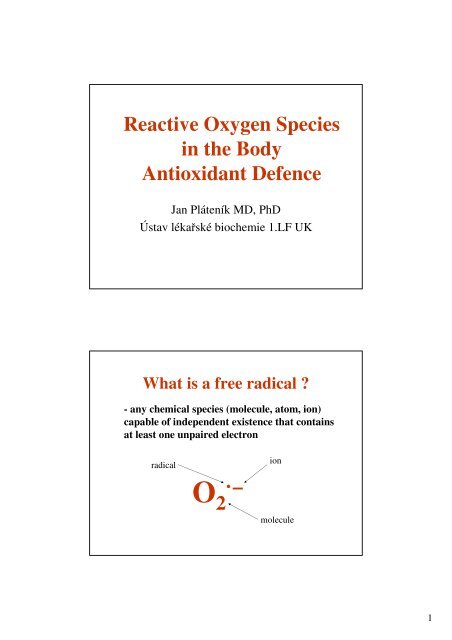
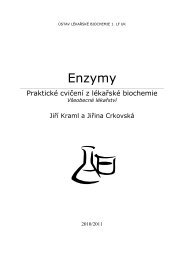
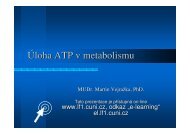
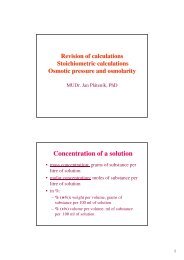
![(Microsoft PowerPoint - ATP angl.ppt [Re\236im kompatibility])](https://img.yumpu.com/46799556/1/190x134/microsoft-powerpoint-atp-anglppt-re236im-kompatibility.jpg?quality=85)

